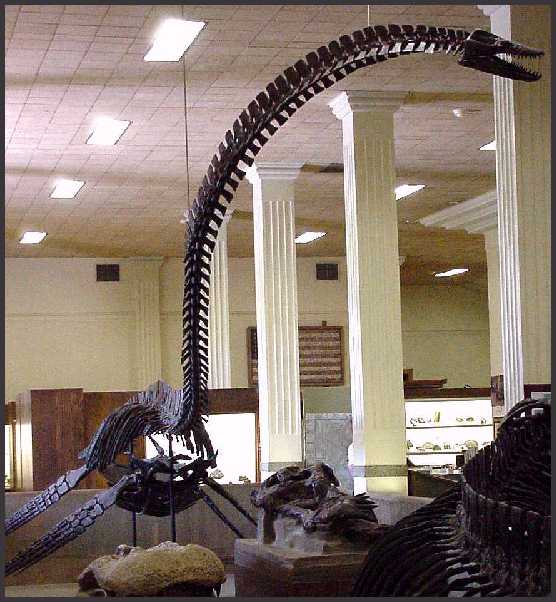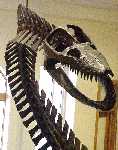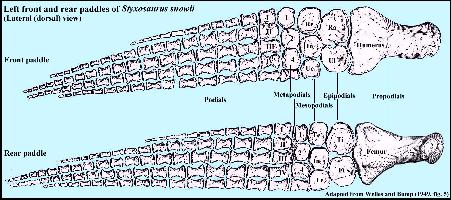
Styxosaurus snowii
An elasmosaur at the Museum of Geology,
South Dakota School of Mines and Technology
Copyright © 2000-2008 by Mike Everhart
 |
Styxosaurus snowii An elasmosaur at the Museum of Geology, South Dakota School of Mines and Technology Copyright © 2000-2008 by Mike Everhart Updated 03/14/2008 |
 |
This page features the mount of a large (36 feet long) elasmosaur (SDSMT 451) in the collection of the Museum of Geology at the South Dakota School of Mines and Technology. It was the type specimen of Alzadasaurus pembertoni, discovered near Iona, South Dakota in 1945 but has since been re-identified as "just another" Styxosaurus snowii, albeit the most complete one ever found. The specimen was first described by S. P. Welles and James Bump in 1949 (Alzadasaurus pembertoni, a new elasmosaur from the Upper Cretaceous of South Dakota, Journal of Paleontology, Vol. 23, No. 5, pp. 521-535) and the name was revised to Stysoxaurus by Ken Carpenter (1999). (NOTE: The holotype of Styxosaurus snowii is at the University of Kansas (KUVP 1301), The SDSMT 451 plesiosaur was found with 253 gastroliths (stomach stones) in it's abdomen. The gastroliths are on display in a case at the museum. Pictures of a several of these gastroliths are shown below. If you are interested in learning more about gastroliths in plesiosaurs, CLICK HERE. For more about plesiosaurs in general, CLICK HERE. The following pictures were taken in July and September 2000. |  |
 |
A right side view of the skull of Styxosaurus snowii. The skull was difficult to photograph because it is about 15 feet above the floor of the museum and is dark brown in color. |
 |
Another view of the right side of the skull showing the first few cervical (neck) vertebrae. For a picture of another skull of Styxosaurus snowii in the Museum of Natural History at the University of Kansas, CLICK HERE. |
 |
Slightly different angle... better lighting (added 09/23/00). These pictures were taken while balancing on a long ladder.... |
 |
Shot from above the skull, showing the upward facing orbit of the right eye. Many artists have shown elasmosaurs with their heads held high above the water. Not only was this physically impossible (try it yourself by lifting a long pole out of the water while floating), there was no way that the plesiosaur could see beneath his chin. |
| GASTROLITHS (STOMACH STONES) |
To read a recent paper about large plesiosaur gastroliths from Kansas and see more gastrolith pictures, CLICK HERE. |
Below are pictures taken in December, 1999 during my "walk-around" of this impressive mounted specimen.
Picture 1 is looking at the right front of the chest and right front paddle of the plesiosaur. The neck is going off to the upper right. Picture 2 is a view of the right rear paddle and abdomen. Notice the gastralia (belly ribs) that cover (and protect?) the lower portions of the abdomen. This is one reason why a plesiosaur was described as "a snake drawn through the shell of a turtle"(*). The long (18') neck disappears to the upper right. Picture 3 shows the 'south-end of a north-bound plesiosaur' and illustrates the pelvic girdle fairly well. The relatively short tail was probably not used in swimming but may have been used as a rudder. Picture 4 shows the pectoral girdle from the left side. The objects on the floor are ammonites.
| (*) While the source of this quote has been a mystery for a number of years, it was solved by Richard Forrest in September, 2005. Richard found that it was apparently first used in a German publication (Dames, Wilhelm [Barnim]. 1895. Die Plesiosaurier der süddeutschen Liasformation. Abhandlungen der Königlichen Akademie der Wissenschaften in Berlin (physics-math), pp. 1-83, pls. i-v. [The plesiosaurs of the Lias Formation of southern Germany]). Quote "...dass man Plesiosaurus mit einer durch einen Schildkrõtenpanzer gezogenen Schlange vegleich ..." which translates as "...one can compare the Plesiosaurus to a snake threaded through the shell of a turtle.." It is also mentioned in Zarnik (1925), which was written in Serbo-Croat (Zarnik, B.; 1925; Sketologiji plesiosauriija, sa prinosima mehanici kraljeznice u recentnih sauropsida.; Societas Scientiarum Naturalium Croatica, Hrvatskoga Naravoslovno Drestva; 38-39 pp.424-473 (On the ethology of plesiosaurs with contributions to the mechanism of the cervical vertebrae of recent sauropsids) . |
 |
Although plesiosaurs evolved from terrestrial reptiles with four
legs, the limbs were highly modified into paddles, and lost most of the mobility of the
elbow / knee, wrist / ankle and fingers / toes. The bones of the wrist became specialized
to the point that they have had to be given different names (no longer carpals or
tarsals). LEFT: A lateral (dorsal) view of the left front and rear limbs of Styxosaurus snowii (SDSMT 451) as adapted from Welles and Bump (1949, pl. 5) Abbreviations: Ra = Radius; Ul = Ulna; Ti = Tibia; Fi = Fibula; Re = Radiale; In = Intermedium; Ue = Ulnare; Te = Tibiale; Fe = Fibulare. |
FOR MORE INFORMATION ABOUT PLESIOSAURS
Where the elasmosaurs roam.... Prehistoric Times (#53, April, 2002)
On a Plesiosaur dig with The New Jersey State Museum -1991
Completing the dig with the New Jersey State Museum -1992
"We Dug Plesiosaurs" - with the Cincinnati Museum in 1998
The 1999 Cincinnati Museum Plesiosaur DigA webpage about Plesiosaurs (Elasmosaurs)
A webpage about Pliosaurs (short-necked plesiosaurs)
Plesiosaur References: A listing of publications related to plesiosaurs
A list of references in my library about mosasaurs and plesiosaurs.
Plesiosauria Translation and Pronunciation Guide
Richard Forrest's listing of plesiosaur specimens and literature
Also, you can visit Ray Ancog's Plesiosaur FAQ Page (Frequently Asked Questions)
Brown, B., 1904. Stomach Stones and the Food of Plesiosaurs, Science, 20(501):184-185.
Carpenter, K., 1999. Revision of North American Elasmosaurs from the Cretaceous of the Western Interior, Paludicola, 2(2):148-173.
Cicimurri, D. J. and M. J. Everhart, 2001. An elasmosaur with stomach contents and
gastroliths from the Pierre Shale (late Cretaceous) of
Kansas. Kansas Acad. Sci. Trans 104(3-4):129-143.
Darby, D. G. and Ojakangas, R. W., 1980. Gastroliths from an Upper Cretaceous Plesiosaur. Jour. Paleon. 54(3):548-556.
Everhart, M. J., 2000. Gastroliths associated with plesiosaur remains in the Sharon Springs Member of the Pierre Shale (late Cretaceous), Western Kansas. Kansas Acad. Sci. Trans. 103(1-2):58-69.
Everhart, M. J., 2002. Where the elasmosaurs roam...... Prehistoric Times 53:24-27.Everhart, M. J. 2003. First records of plesiosaur remains in the lower Smoky Hill Chalk Member (Upper Coniacian) of the Niobrara Formation in western Kansas. Kansas Academy of Science, Transactions 106(3-4):139-148.
Everhart, M. J. 2004. New data regarding the skull of Dolichorhynchops osborni (Plesiosauroidea: Polycotylidae) from rediscovered photos of the Harvard Museum of Comparative Zoology specimen. Paludicola 4(3):74-80.
Everhart, M.J. 2004. Plesiosaurs as the food of mosasaurs; new data on the stomach contents of a Tylosaurus proriger (Squamata; Mosasauridae) from the Niobrara Formation of western Kansas. The Mosasaur 7:41-46.
Everhart, M.J. 2005. Bite marks on an elasmosaur (Sauropterygia; Plesiosauria) paddle from the Niobrara Chalk (Upper Cretaceous) as probable evidence of feeding by the lamniform shark, Cretoxyrhina mantelli. PalArch, Vertebrate paleontology 2(2): 14-24.
Everhart, M.J. 2006. The occurrence of elasmosaurids (Reptilia: Plesiosauria) in the Niobrara Chalk of western Kansas. Paludicola 5(4):170-183.
Everhart, M. J. 2007. Use of archival photographs to rediscover the locality of the Holyrood elasmosaur ( Ellsworth County , Kansas ). Kansas Academy of Science, Transactions 110(1/2): 135-143.
Martin, J. E. and Kihm, A. J., 1988. Two Unusual Stratigraphic
Occurrences of Plesiosaurs from Late Cretaceous Formations of the Black Hills Area,
Wyoming and South Dakota, Proc. S.D. Acad. Sci. 67:73-75.
Martin, J. E. and Kennedy, L. E., 1988. A Plesiosaur from the Late Cretaceous (Campanian)
Pierre Shale of South Dakota: A Preliminary Report, Proc. S.D. Acad. Sci. 67:76-79.
Martin, J. E., B. A. Schumacher, D. C. Parris, and B. S. Grandstaff, 1998. Fossil
Vertebrates of the Niobrara Formation in South Dakota, Dakoterra 5:39-54.
Riggs, E. S., 1939. A Specimen of Elasmosaurus serpentinus, Field Museum of Natural History, Geology, 6:385-391.
Schumacher, B.A. and M.J. Everhart. 2005. A stratigraphic and taxonomic review of plesiosaurs from the old “Fort Benton Group” of central Kansas: A new assessment of old records. Paludicola 5(2):33-54.
Shuler, E. W., 1950. A new elasmosaur from the Eagle Ford Shale of Texas. Part II. Fondren Science Series V1, #2, 1-33 pp. 26 figs.
Storrs, G. W., 1981. A Review of Occurrences of the Plesiosauria
(Reptilia: Sauropterygia) in Texas with Description of New Material, Masters Thesis, The
University of Texas at Austin, 226 pages.
Storrs, G. W., 1984. Elasmosaurus platyurus and a page from the Cope-Marsh war.
Discovery 17(2):25-27.
Storrs, G. W., 1997. Morphological and Taxonomic Clarification of the Genus Plesiosaurus,
pp. 145-190, In Calloway, J. M. and Nicholls, E. L., eds, Ancient Marine Reptiles,
Academic Press.
Storrs, G.W., 1999. An Examination of Plesiosauria (Diapsida: Sauropterygia) from the
Niobrara Chalk (upper Cretaceous) of Central North America, The University of Kansas
Paleontological Contributions, (N. S.), No. 11, 15 pp.
Taylor, M. A., 1981. Plesiosaurs - rigging and ballasting, Nature
290:628-629.
Taylor, M. A., 1986. Lifestyle of plesiosaurs, 1986, Nature 319:179.
Taylor, M. A., 1993. Stomach Stones for feeding or buoyancy? The occurrence and function
of gastroliths in marine tetrapods, Phil. Trans. R. Soc. Lond. B 341:163-175.
Taylor, M. A., 1994. Stone, bone or blubber? Buoyancy control strategies in aquatic
tetrapods, pp.151-161, In Maddock, L., Bone, Q., and Rayner, J. M. V. (ed.), Mechanics and
Physiology of Animal Swimming, Cambridge University Press.
Welles, S. P., 1943. Elasmosaurid plesiosaurs with a description
of the new material from California and Colorado. University of California Memoirs
13:125-254. figs.1-37., pls.12-29.
Welles, S. P., 1949. A new elasmosaur from the Eagle Ford Shale of Texas, Fondren Science
Series, Southern Methodist University, 1:1-28.
Welles, S. P., 1952. A review of the North American Cretaceous elasmosaurs. University of
California Publications in Geological Sciences 29:46-144. figs. 1-25.
Welles, S. P. 1953. Jurassic plesiosaur vertebrae from California. Jour. Paleon.
27:743-744, 1fig.
Welles, S. P., 1962. A New Species of Elasmosaur from the Aptian of Columbia and a Review
of the Cretaceous Plesiosaurs, University of California Press, Berkeley and Los Angeles.
Welles, S. P., and Bump, James, 1949, Alzadasaurus pembertoni, a new elasmosaur from the Upper Cretaceous of South Dakota, Jour. Paleon. 23(5): 521-535.
Williston, S. W., 1893. An Interesting Food Habit of the Plesiosaurs, Trans. Kansas Acad. Sci. 13:121-122, 1 plate.
Williston, S. W., 1903. North American Plesiosaurs, Field Columbian Museum, Pub. 73, Geological Series, 2(1):1-79, 29 plates.
Williston, S. W., 1906. North American Plesiosaurs: Elasmosaurus, Cimoliasaurus, and Polycotylus, Amer. Jour. Sci. 4(21):221-236.